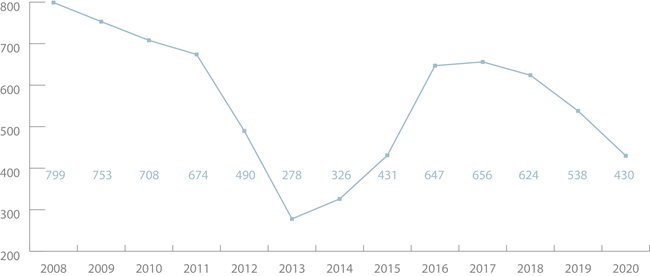Health and Safety
Health and safety of its employees is a key focus of the concrete industry strategy. Two indicators are used to report performance. These are established benchmarks of health and safety:
- The number of Reportable Injuries* per 100,000 direct employees per annum
- Lost Time Injuries** for direct employee per 1 million hours worked
Performance indicator: Reportable injuries per 100,000 direct employees per annum

In 2020, the reportable injury frequency rate was 430 reportable injuries per 100,000 direct employees.
It should be noted that 2020 saw a series of lockdowns as part of the UK’s response to the global COVID-19 pandemic. UK Government quickly realised the essential nature of construction and mineral products and the concrete supply chain was quick to restart. However, there was a considerable impact on staffing and production levels throughout 2020 due to COVID. This disruption has had an impact on the data supplied from the product sectors. The UK Concrete Sustainable Construction Group has made the decision to publish 2020 data, however it should be noted that 2020 data has the potential to be an anomaly in some cases.
*A Reportable Injury is defined as any injury that is reportable under the Reporting of Injuries, Disease and Dangerous Occurrences Regulations 1995 (RIDDOR). In 2012 the HSE definition of reportable changed to from 3 days to 7 days. The concrete industry indicator will remain at 3 days.
Performance indicator: Lost Time Injuries (LTI) for direct employees per 1 million hours worked
| Year |
Concrete |
Concrete and Reinforcement |
| Baseline 2010 |
6.5 |
6.5 |
| 2011 |
6.3 |
7.0 |
| 2012 |
4.6 |
4.5 |
| 2013 |
5.8 |
5.6 |
| 2014 |
3.4 |
3.4 |
| 2015 |
4.3 |
4.3 |
| 2016 |
3.9 |
3.8 |
| 2017 |
4.0 |
3.9 |
| 2018 |
3.5 |
3.6 |
| 2019 |
3.4 |
3.5 |
| 2020 |
3.3 |
3.3 |
**A Lost Time Injury is defined as an occupational injury resulting in the absence of the injured party for one or more working shifts.
The concrete industry is committed to continuous improvement and Health and Safety is our first priority.
Incidents are being reviewed and key learning points shared across sectors to improve future performance and restore progress towards lowering these two indicator values.
2020 Strategy Commitment
The concrete industry sustainable construction strategy supports the industry targets for Health and Safety set by the Mineral Products Association (MPA): the industry aim is to achieve zero harm
From 2009-2014 the target was to reduce lost time incidents (LTI) by 50%, with the aim of zero harm. Concrete industry data shows that between 2010 and 2014, the industry achieved a 48% reduction in LTI and in the same period achieved a 54% reduction in reportable injuries.
In 2014 a new five year target for the MPA started. This target has been adopted by the Concrete Industry Sustainable Construction Strategy. The target is to reduce lost time incidents, by a further 65% by 2019, from the 2014 baseline.
The concrete industry is committed to: protecting life and quality of life. As part of the Mineral Products Association, the concrete industry is committed to initiatives for health & safety, employment & skills, vulnerable road users, and local community liaison.